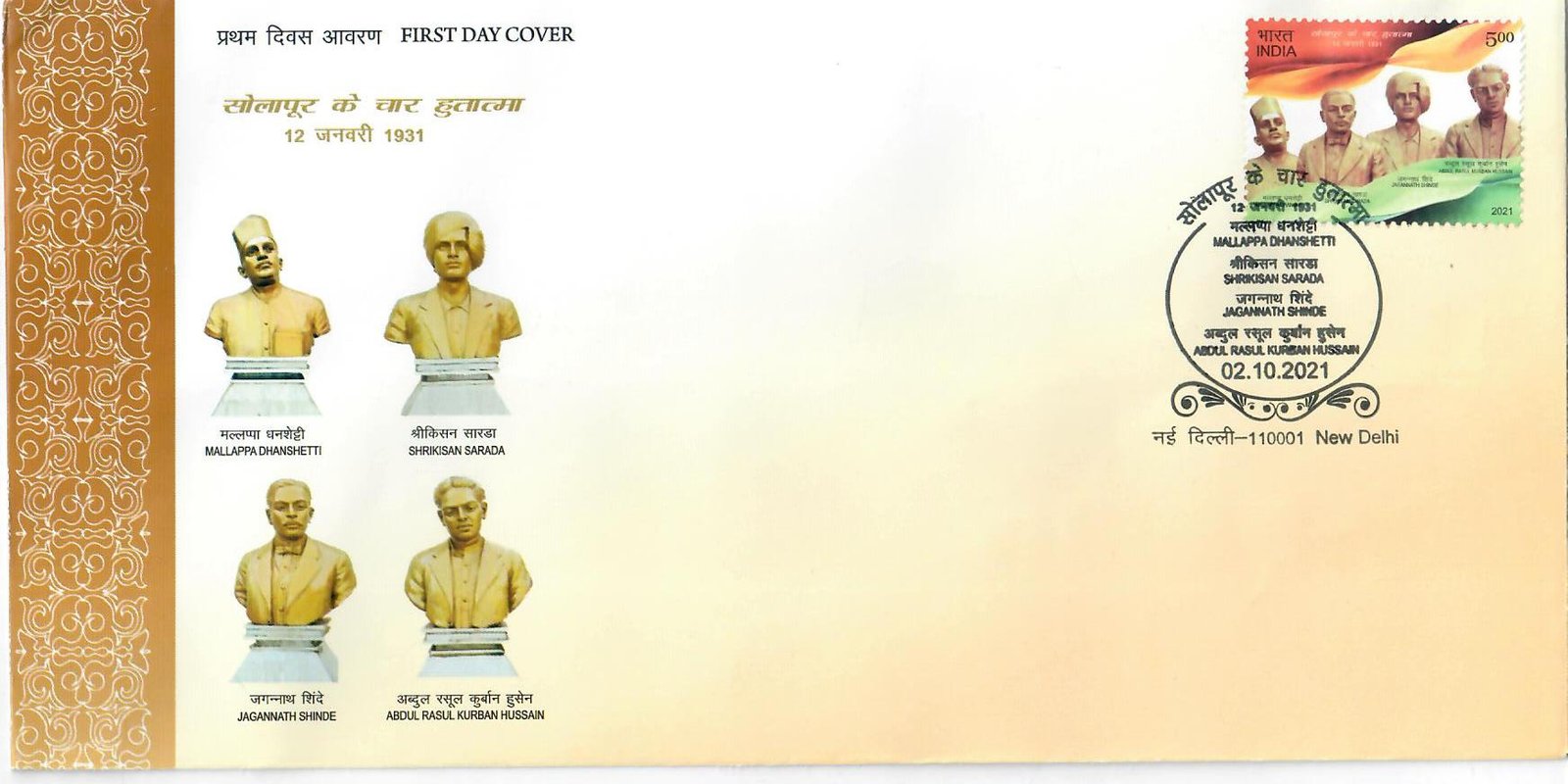Martyrs of Solapur

Technical Data
| Date of Issue | October 2, 2021 |
|---|---|
| Denomination | Rs. 5 |
| Quantity | 302,400 |
| Perforation | 13¼ x 13¾ |
| Printer | Security Printing Press, Hyderabad |
| Printing Process | Wet Offset |
| Watermark | No Watermark |
| Colors | Multicolor |
| Credit (Designed By) | Smt. Alka Sharma |
| Catalog Codes |
Michel IN 3740 Stamp Number IN 3258 Yvert et Tellier IN 3415 Stanley Gibbons IN 3788 |
| Themes | Famous people | Flags | Independency Activists | Men |
Commemorative Stamp Honouring the Solapur Martyrs of 1931
India’s struggle for independence was shaped not only by its iconic leaders but also by countless unsung heroes who sacrificed their lives for freedom. Among them were Mallappa Dhanashetti, Shrikisan Sarada, Jagannath Shinde, and Abdul Rasul Kurban Hussain, four patriots from Solapur who stood united against British oppression. To honour their sacrifice, the Department of Posts has issued a commemorative postage stamp remembering their courage and contribution to the nation.
Mallappa Dhanashetti (1898–1931)
Born in 1898, Mallappa Dhanashetti was admired for his leadership and ability to connect with the masses. He inspired people during religious and cultural gatherings, from the Siddharameshwar fair to Ganesh processions and Rath Yatras, turning them into platforms for national awakening. His courage in calming agitated crowds and his commitment to protecting fellow citizens marked him as a true leader of Solapur’s freedom movement.
Jagannath Shinde (1906–1931)
Jagannath Shinde, born in 1906, embodied perseverance, fearlessness, and dedication to social justice. Actively involved in the Railway and Mill Workers Union, he worked tirelessly to secure scholarships for underprivileged Maratha children and uplift the working class. He also participated in the Satyashodhak Parishad in Mumbai, reflecting his deep commitment to equality and reform. His role as an organiser made him a vital force in Solapur’s resistance.
Abdul Rasul Kurban Hussain (1910–1931)
Born in 1910 into a family of frame makers, Abdul Rasul Kurban Hussain drew inspiration from Lokmanya Tilak and Mahatma Gandhi. Guided by the principles of freedom, swadeshi, equality, socialism, and Hindu-Muslim unity, he was a passionate writer and speaker. Through his efforts in rallies, labour movements, and his weekly Gajanfar, he championed communal harmony and became a symbol of patriotic unity.
Shrikisan Sarada (1893–1931)
Shrikisan Sarada, born in 1893, was a respected figure in Solapur who generously supported religious and social causes. When Mahatma Gandhi was arrested in May 1930, Sarada was at the forefront of the protests that followed in Solapur. The strikes, marches, and symbolic acts of defiance shook the colonial administration. His financial support to the movement and unwavering patriotism made him a target of British ire.
The Solapur Tragedy and Martyrdom
The events of May 1930 in Solapur marked a turning point. When peaceful protests escalated after brutal police action, the British administration, under Collector Knight, targeted these four leaders. False charges were fabricated, witnesses silenced, and the trial turned into a mockery of justice. Despite their innocence, Mallappa Dhanashetti, Jagannath Shinde, Abdul Rasul Kurban Hussain, and Shrikisan Sarada were sentenced to death.
On January 12, 1931, the day of the Siddharameshwar fair, the four patriots were hanged. The choice of the day was a deliberate attempt by the British to intimidate the local population. Instead, their martyrdom became a rallying cry for freedom, inspiring generations to continue the fight for independence.
A Stamp of Remembrance
The commemorative postage stamp issued by India Post pays tribute to these four martyrs of Solapur. Their sacrifice is a reminder that India’s independence was achieved not only by well-known leaders but also through the courage of countless revolutionaries who gave their lives so the nation could breathe free.
First Day Cover

